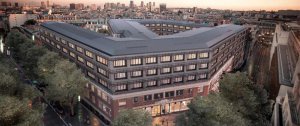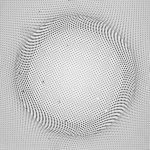One year post-doctoral position at ESPCI ParisTech,
Friction of soft surfaces is a key issue in many practical situations such as, for instance, tire design and touch feeling. One of the complexities of this problem arises from the roughness of the contacting surfaces. When macroscopic bodies are pressed together, contact only occurs at localized spots between surface asperities. Friction thus involves the shearing of a myriad of micro-contacts which are distributed over length scales ranging from micrometers down to nanometers. Although widely debated, the manner in which these micro-contacts locally dissipate energy remains obscure especially when viscoelastic losses are involved.
In an effort to address these issues, the project will focus on an experimental investigation of the friction of viscoelastic rubbers using an original torsional contact configuration [1] where a glass lens is twisted on the rubber substrate (see picture above). As compared to more conventional linear sliding experiments, torsional contacts present the advantage of providing direct access to interface dissipation without the complications arising from viscoelastic losses within the bulk substrate. Newly developed contact imaging methods [2,3] will be used which allow measuring surface displacement fields and the associated local friction law. In order to investigate frictional dissipation at various length scales, the topography of the lens will be varied in a systematic way using patterning techniques.
The project includes the patterning of glass surfaces using soft photolithography, friction experiments, image analysis and theoretical analysis using contact mechanics approaches.
By the time she/he applies, the candidate will have obtained or will be close to complete an experimental PhD in the general fields of physics or mechanics. Her/his field of expertise should be in either one of the following domains, ranging from soft matter physics or adhesion to contact and/or fracture mechanics.
This project is part of an ongoing collaboration between PPMD at ESPCI, SVI joint CNRS/Saint Gobain Laboratory (www.saint-gobain-recherche.com/svi/en/ ) and LPS at ENS (www.lps.ens.fr/ ). Strong interactions with partners at SVI and LPS are planed during the course of the post-doc.
This one year post-doc position is funded by the French National Research Agency (ANR).
[1] A. Chateauminois, C. Fretigny and L. Olanier, Phys Rev E 81, 026106 (2010)
[2] A. Chateauminois, C. Fretigny, Eur. Phys. Journal E : 27 (2008) 221-227 ; Highlight in Europhysics News, 39 (6) 2008
[3] D.T. Nguyen et al, J. of Adhesion 87 (2011) 235-250
Location
Laboratoire de Physico-Chimie des Polymères et des Milieux Dispersés
« Out of Equilibrium Soft Matter » team
Ecole Supérieure de Physique et Chimie Industrielles (ESPCI), Paris, France









